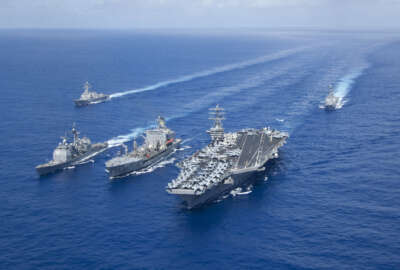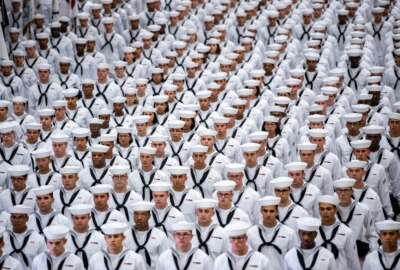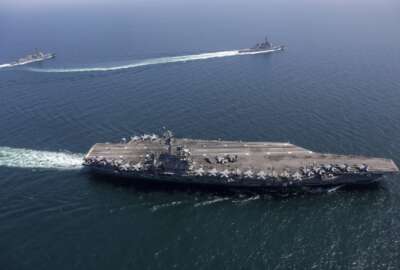
This Navy unit helps ensure the advantage in conflict under the surface
This week the Federal Drive is exploring the activities under the Naval Oceanography Operations Command. For details about his work in Yokosuka, Japan, Naval Oc...
Best listening experience is on Chrome, Firefox or Safari. Subscribe to Federal Drive’s daily audio interviews on Apple Podcasts or PodcastOne.
This week we’re exploring the activities under the Naval Oceanography Operations Command. Among its most crucial missions, ensuring superiority of the fifth and seventh fleets in the submarine domain of the Pacific. For more details, Naval Oceanography Antisubmarine Warfare Center’s commander, Christopher Tuggle from Yokosuka, Japan joined the Federal Drive with Tom Temin.
Tom Temin Tell us exactly what the center does with respect to submarine warfare and how you interact with the fleet and with the Navy writ large.
Christopher Tuggle Okay, so we have technically three different missions. First and foremost, we provide asymmetric warfighting advantage for antisubmarine warfare (ASW) forces in the seventh, fifth and third fleets, through the exploitation of oceanographic environmental data to optimize ASW forces, sensors and platforms. So that’s first and foremost, what we do.
Tom Temin Well lets put that in English for a minute so,
Christopher Tuggle Yes sir.
Tom Temin Symmetric means we’re better at it than the enemy potentially.
Christopher Tuggle Exactly. It’s exploiting the environment to give us that advantage that favors us more than our adversaries do.
Tom Temin And if the adversary and U.S. forces are operating in the same environment, what is it that can give one side an advantage in that case?
Christopher Tuggle It’s a clear and complete understanding of the environment. Knowing where to put your sensors, knowing where to put your forces in relation to weather. Whether you want to be on one side of a significant weather feature that can hide your forces and ability to see them further or vice versa. It’s about positioning and optimizing the use of our naval assets.
Tom Temin Got it. And so I guess the implicit thing here is that weather can affect what goes on under the sea, just as much as it can on the surface?
Christopher Tuggle Yes, sir. The ocean environment is very complex, especially out here in the seventh fleet area of operations. You have a lot of complex underwater bathymetry, or topography, a lot of ocean vents, a lot of circulations where submarine forces can leverage and exploit and hide in those where some of our sensors can’t see unless, of course, you know where to look and you know where to put the sensor. And that’s where we come in. We help optimize the search patterns and utilization of our Navy sensors to best find, locate and track our adversaries.
Tom Temin And these sensors take what form?
Christopher Tuggle So we have . Those are towed on different surface platforms, whether they’re cruisers or destroyers, or SURTASS ships, essentially ships that look passively for long ranges, looking for acoustic signatures. And then of course, our submarine force as well utilize different passive and active acoustic means of detection.
Tom Temin Could they also be buoys and that kind of thing? Things that might be anchored, or is it pretty much mobile?
Christopher Tuggle A lot of them are mobile. Now our aviation forces, our P-8s and used to be our P-3s, they can drop buoys, both passive and active buoys, that can listen specifically for acoustic tones that were of interest. And then, of course, some of our helicopters that we may have embarked on our cruisers or destroyers, where aircraft carriers can run a dipping sonar tail, when we have clear indication that there is a subsurface adversary in this particular area and help localize.
Tom Temin Pretty amazing stuff. So then the output then of your command is data basically?
Christopher Tuggle Oh more than data. We obviously provide data, we utilize that data. We turn it into information. We turn it into decisions. We turn it into recommendations. So we do the analysis, and also the predictions. And also tell the commanders where they should put their sensors. Our job is to try and get ahead of the enemy’s decision calculus. Where do they want to hide? Where should they hide? And how do we put our sensors there so when they go there, we’re already waiting for them?
Tom Temin And what about the enemies, or the potential adversaries, sensors? I mean, a lot of this technology is open nowadays. And so how do you make sure that even if they had the same sensors, although I’m sure they don’t have P-8s and the number of destroyers and other ships that can drag up the towed sensors that you mentioned. But still, this is becoming a more open and lower cost to entry type of activity?
Christopher Tuggle Yes, sir. So once again, it’s understanding the environment and being able to leverage those same underwater features, those same acoustic disrupters, to hide our assets as well — to set up ambush points to put them in the right place to hide and be able to pop out and gain contact or be where we want them to be.
Tom Temin We’re speaking with Commander Christopher Tuggle. He’s commander of the Naval Antisubmarine Warfare Center in Yokosuka, Japan. And just if you would maybe, give us a little bit of background on submarine operations when the United States is not conducting a exercise, say by itself or with other nations, yet the submarines are deployed. What are they doing, essentially and how does this play into that mission? Because you know, we’re not at war in submarines or with any other weapons at the moment, but what are they doing when they’re not exercising and rehearsing?
Christopher Tuggle Unfortunately, a lot of that information is classified.
Tom Temin That’s what I figured you’d say.
Christopher Tuggle But I can tell you, you know, they are continuing to ensure the international rules based order by ensuring that international waterways remain open and free. They also go out and this is, you know, part of common knowledge, they’re part of our nuclear triad. They are out there conducting missions to ensure that should we need that capability they remain undetected, they remain free to conduct the nation’s missions.
Tom Temin All right, and let’s talk about the command itself. What kinds of numbers of people do you in Japan? How many uniforms? What about civilian help and contractor support?
Christopher Tuggle Yes, sir. So inside building 3304 — what they call weather hill. We actually are up on top of the hill, one of the most beautiful spots on Fleet Activities Yokosuka — we have about 40 personnel. Three civilians that compromise my IT department, what we call N6. We also have a couple of contractors that also work inside of the N6, the IT department. Also located in there are a couple IT enlisted sailors and electronics technicians. Their job is to keep our computers and our networks up and running. And for the electronics technicians, we have weather sensors that we have on our installation and located on installations throughout the region that help us gain a better picture of what the weather conditions are like. Also, we have about 30 other sailors that are part of my operations department. They conduct our mission. Not only our ASW mission, but our resource protection mission as well, which is to keep Navy region Japan installations safe from natural disasters, hazardous weather by reporting and forecasting and informing those commanders. We also have three detachments that are not actually located in Yokosuka as well. We have detachment in Misawa, Japan; we have a detachment in Kadena, Japan there on Okinawa and then we also have another detachment in Whidbey Island, Washington. All three of those detachment support our maritime patrol and reconnaissance forces, our aviation forces, the P-8s and the P-3 that support Navy intelligence, surveillance and reconnaissance missions, and also antisubmarine warfare missions here in the seventh fleet theater.
Tom Temin And in talking with some of the other commanders of other units under naval oceanography operations, I get the sense that you’re all highly matrix because a lot of people have sensors and are gathering weather and surface, and in your case subsurface data, and so there must be some integrative function at the overall command level that brings us all together so that everyone’s data can be inculcated into a full picture that is then distributed throughout all the different subcommands. Does that make sense?
Christopher Tuggle Yes, sir. Makes perfect sense. You actually captured very nicely. All of that data flows through Fleet Numerical Meteorology and Oceanography Command, FNMOC, as some man know it. And of course, it’s also displayed and distributed through our Maritime Operations Center there at CNMOC, the CTG-80.7 MOC. So all of the data that’s compiled, distributed, turned into either tactical decision aids or even numerical weather prediction or ocean prediction models, is viewable either through FNMOC directly, or globally, Navy wide or Meteorology & Oceanography (METOC) wide field. So yes, sir, it is complex, but we do have a great clearing house that brings us all together and helps turn that data into decisions.
Tom Temin And just briefly tell us about yourself how you came to this particular perch on a hill in the Navy.
Christopher Tuggle Oh wow, it’s quite the journey. Starting out actually never wanted to be in the Navy, honest with you. I was a sophomore in college, and the Navy gave me an offer I couldn’t refuse. That was called the Baccalaureate Degree Completion Plan. I give them two years of college. I go to Officer Candidate School, and I give them four years. I was like, okay, four years of experience. Not so bad. I want to be meteorologist and so I give for years and I get to serve our country. Well, 20 years later, here we are talking on the Federal Drive. Prior to this job, though, I was the seventh fleet oceanographer. So I had the pleasure of serving the three star staff and all the forces in seventh fleet advising, the commander and all the other commanders on the exploitation and planning from the strategic and operational level on how to exploit the battlespace or the environment.
Tom Temin I get the sense that oceanography and meteorology are chiaroscuro of the same YinYang of almost the same field of study.
Christopher Tuggle Yes, sir. The physics are very similar. When you look at fluid dynamics, fluid mechanics, is just a different medium. Water versus the atmosphere. The atmosphere is a lot more dynamic in a general sense than the ocean. Things typically move slower in the ocean than they do in the atmosphere, but once you understand the basic science, you can apply it in the same way. So I grew up with a love of meteorology, love and fascinated by tornadoes and tropical cyclones and as I became a naval METOC Officer, I grew to love the ocean as well through its study and application.
Tom Temin So you must really have good conversations with the typhoon command people.
Christopher Tuggle Yes, sir. The commanding officer of Joint Typhoon Warning Center is a close friend of mine and we definitely have lots of communications. One of our missions is providing tropical cyclone condition and readiness recommendations to Fleet Activities Yokosuka, Fleet Activities Sasebo. Joint Typhoon Warning Center provides the predictions of the storms and then what we do is we take the storm motion and the intensity and we translate it into what that’s going to mean at the local fleet installations. Do they need to shelter in place? Do they need to cancel operations? Do they need to make certain preparations to keep the ships and the people that live on the base safe?
Tom Temin And just a final question when there’s really churning weather that is churning the ocean do submarines surface or do they dive and stay deep under it?
Christopher Tuggle Well, the answer it depends, right? Depends on where they are, how shallow the water is, but most of the time, they’re just gonna dive deep. They’re gonna go below it and enjoy life without the turbulent stuff going up on top.
Tom Temin Commander Christopher Tuggle is commander of the Naval Antisubmarine Warfare Center, Yokosuka, Japan. Thanks so much for joining me.
Christopher Tuggle Of course. It’s been my pleasure, sir.
Copyright © 2024 Federal News Network. All rights reserved. This website is not intended for users located within the European Economic Area.
Tom Temin is host of the Federal Drive and has been providing insight on federal technology and management issues for more than 30 years.
Follow @tteminWFED





